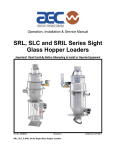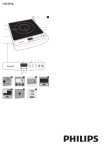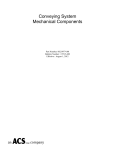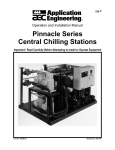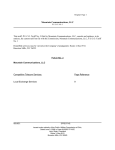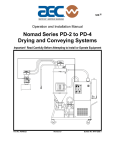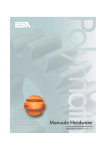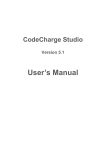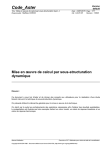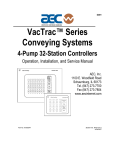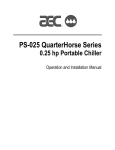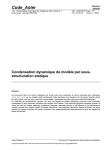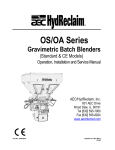Download System Manual Group 13
Transcript
Electro-Mechanical Drum Filling Station Group 13: Ryan Trimmer Mathew Dunbar Brandon Rau Seth Howdershelt ABSTRACT As college students, we are asked to complete a capstone project to put many things we learned throughout college to a real world application. As engineering students, luckily we get to choose our own capstone project. This project should be something that involves many things we have learned and even things that we haven’t. This project is very important, as it puts the students in a real world engineering design process and teaches them that there is a lot more work to being an engineer than just designing and building things. Eagle manufacturing has come in contact with us and asked us to design a machine that will automate a process that takes their maintenance workers hours a day. This machine will fill drums of specified sizes to specific weights via two fill materials. To start this project, we collaborated with Eagle’s head electrician and various engineers to come up with a design that they could use and fix if it were to incur problems. This design involved using materials and components that they are already using in their manufacturing plant. We did not achieve everything that we had planned, partially because of funding issues and partially due to the fact that there was more to the design and integration than initially thought. We did achieve a HMI program, a PLC program, a complete parts list with prices, and a finalized design proposal to submit to Eagle. I feel that although we did not complete our project, we learned many important lessons. We learned that it takes time to allocate money for building things, that it is more involved than just combining the parts needed together, and that Electrical Engineering is a very broad topic. TABLE OF CONTENTS Introduction ___________________________________________________________ 1 Design Achievements ____________________________________________________ 2 Hardware Design _______________________________________________________ 3 Price Analysis _____________________________________________________________ 3 AEC Vacuum Pump Brochure ______________________________________________ 13 AEC Vacuum Pump Spec Sheet _____________________________________________ 15 AEC Vacuum Reciever Brochure____________________________________________ 19 AEC Vacuum Reciever Spec Sheet __________________________________________ 21 AEC Proportioning Valve Spec Sheet ________________________________________ 25 Software Design _______________________________________________________ 27 HMI Screen _____________________________________________________________ 28 PLC Program ____________________________________________________________ 36 Test Results___________________________________________________________ 43 Safety Precautions _____________________________________________________ 44 Reflections _________________________________________________________________ 45 APPENDIX 1: USER MANUAL _________________________________________ 46 APPENDIX 2: MAINTENANCE MANUAL ________________________________ 47 APPENDIX 3: Original Design Proposal ___________________________________ 48 APPENDIX 4: Summary of Changes ______________________________________ 62 Introduction There are various requirements in which the drum filling station must achieve. One objective is to fill the drums to a specified weight for testing purposes. The station must gather data from the scale, which will determine whether the PLC program continues or stops the fill cycle based on the current weight of the drum. The weights will be implemented into the PLC program beforehand so that there is no need for the user to input a weight. Another difficulty comes with the design of the hopper. The design will require several key components in order to keep an even flow of the material and a simple means of opening/closing the hopper based on whether the user is starting a fill or ending one. The last of the requirements comes within the software design. The first aspect to the program will be to find a way to implement a scale and a PLC so that the scale output can be read by the PLC and the program continue running based upon that output. The program must also interface with the HMI touch screen so that the fill station may be run by a user with simple on screen directions. Although there may be many requirements that the design entails, this project’s expected value for the company is well worth the time and effort making this drum fill station possible. 1 Design Achievements All components selected and priced (have quotes from manufacturers). Design finalized with the selected components. HMI menu system created. PLC Program created. Density of materials calculated. Created final design proposal for Eagle Manufacturing President. 2 Hardware Design Drum Fill and Weigh Station Project 2015 with WVU Design Team 4-22-15 Blending Station for Drum Fill with Sand and Regrind Plastic to Make Drum Weight AEC VPS1-1.5-1AS Loading System $ 6,610.00 AEC SRC Vacuum Hopper $ 2,700.00 AEC RPV Proportioning Valve $ 2,745.00 AEC Aluminum Double Tube $ 235.00 AEC Dual Tube Pick-Up Wand $ 745.0 0 AEC Flex Hose $ 175.00 AEC Clamps $ 30.00 AEC Blending System Equipment Sub-Total $ 13,240.00 1,000 Lb. Electronic Scale with 4-20mA Output $ 1,199.00 Electrical System to Tie in Blending Station and Electronic Scale Pro-face HMI Screen $ 2,080.00 Allen-Bradley MicoLogix 1100 16 PLC Controller $ 580.29 Allen-Bradley 1606-XL 60W Power Supply $ 282.92 Steel Stand to Mount Hopper (Built by EAGLE) $ 250.00 Contingency Costs $ 367.79 Total Investment Not to Exceed: $ 18,000.00 3 Quote # : IQ-151559-R2 101 - IM - 0302 04/21/2015 Scott Trimmer EAGLE MANUFACTURING CO INC. 2400 CHARLES STREET WELLSBURG, WV 26070 Phone: 304-737-3171 X129 Fax: 304-737-1752 Email: [email protected] Dear Mr. Trimmer: Thank you for requesting the following proposal for AEC Auxiliary Equipment. This proposal provides pricing for AEC Vacuum Conveying equipment. Application data is incomplete at this time however as a general guideline the Vacuum Pumps are sized to handle approximately 600 Lbs. / Hour at approximately 50' Equivalent Conveying distance. Eagle intends to utilize this system to convey HDPE pellets, regrind, and sand. Proposal is updated 4/10/15 to remove the VTTV, upsize the VPS Vacuum Pump, and include Proportioning Valve, Special Dual-Tube Pickup Wands, Hoses, and option Wear-Resistant Packages and enhanced filtering. Proposal is updated 4/21/15 to include enhanced filtering on all items and include wear resistant packages on the Vacuum Receiver and Proportioning Valve. Pricing, together with terms of sale and delivery information, is shown on the attached price page. To assist you in evaluating this proposal, we are enclosing sales literature and component specifications for your review. AEC offers the most technically advanced chilling and mold temperature control systems, conveying systems, dryers and blenders, as well as granulators, robotics and automated parts handling equipment available to industry today. An array of engineering and installation services are available as well as plant layout and other mechanical or structural drawings. Electrical and flow schematics are included with all equipment and systems. Field installation supervision, mechanical installation, and complete turnkey installation services are also available. Thank you for your continued interest in our products and services. Please feel free to contact us at your convenience to discuss any questions you may have. We look forward to being of continued service to you. Sincerely, Dave Manners Systems Engineer - ACS Sales Phone: (847) 273-7708 Fax: (847) 273-7804 [email protected] cc: Craig Bradford ALLEGHENY MACHINERY GRP INC Phone: (724) 794 3058 Fax: (724) 794 3081 Email: [email protected] ic: Keith Larson VP of Sales & Marketing Joe Dziedzic Application Engineering Manager AEC - 1100 East Woodfield Road - Suite 588 - Schaumburg, IL - 60173 Tel: (847) 273-7700 Fax: (847) 273-7804 Web: http://www.aecinternet.com 4 1100 East Woodfield Road Suite 588 Schaumburg, IL 60173 Price Summary EAGLE MANUFACTURING CO INC. Quote #: IQ-151559-R2 Item 101 102 QTY 1 1 Extended Price Price Equipment Description $6,610.00 $6,610.00 VPS1-1.5-1AS Loading System, 460/3/60 Portable Conveying Blower – Filter Assembly 2 HP (1.5 Kw) Pump, 1-Station Includes Blower, 1-Station Controller (does not include Vacuum Receiver) Includes Upgrade to VP16 (acrylic bucket filter) with compressed air filter cleaning $2,700.00 $2,700.00 SRC Series Stainless Receiver HOPPER, VACUUM, SRC04 1.5” Connections, Time Fill Operation Includes Upgrades to polyester cloth filter in lieu of standard screen, Compressed air blowback with stand-alone controller, Wear wrap for abrasive materials. (Includes stainless steel inlet in lieu of standard). Check valve removed. NOTE: Not a warranty item; wear is part of the process 103 1 (Quote # : IQ-151559-R2) RPV Proportioning Valve $2,745.00 $2,745.00 VALVE, PROPORTIONING, RPV-1.50"/1.50"-B24-HM-SPL-SS Abrasive Resistant RPV (stainless steel body) Includes 115/1/60 Supply Voltage – 24VDC Control Voltage Timer Control Box (2) Standard Vinyl Hoses 1.5” x 10’ with Clamps AEC - 1100 East Woodfield Road - Suite 588 - Schaumburg, IL - 60173 Page 2 of 8 5 ae multi quote 104 1 $235.00 W00018213 PICKUP,MATERIAL, ALUMINUM,DOUBLE TUBE,1.5" To be Utilized with RPV and Regrind or HDPE Pelletized Material $235.00 $745.00 $745.00 $3.50 $175.00 105 1 Special 1.25" Dual Tube Pickup Wand Includes Reducer from 1.5” to 1.25” To be Utilized with RPV and Sand Material 106 50’ A0550737 HOSE,FLEX,CLEAR GROUNDED VINYL,1.5” x 50’ Roll Optional: Upgrade Hose to Special Urethane to increase protection against wear – Consult Factory with exact lengths required – Special Order Item 107 10 $3.00 W00001917 CLAMP,HOSE,DIX#32,1.56-2.50 Box of (10) Hose Clamps Estimated Shipment: 7 to 8 Weeks A.R.O. TOTAL: Terms and Conditions ** Submit purchase order to: ** ** ** ** ** ** ** * * * * 1100 Woodfield Road Suite 588 $13,240.00 Schaumburg, IL 60173 Payment due net 30 days commencing with invoice date (orders less than $20,000) 35% down payment due with purchase order, balance due net 30 days (orders that exceed $20,000) commencing with invoice date Equipment over $20,000 and over 8 week leadtime, 35% down payment, (orders that exceed $20,000) 35% before shipment, balance net 30 days International terms: 35% Down Payment with order, Balance Prior to Shipment unless otherwise determined by ACS credit department Unless otherwise specified in this quotation, all shipments are shipped Ex Works, best way-collect Prices do not include provisions for state or local taxes Prices firm for 30 days NOTE: * AEC $30.00 Pictures in this proposal may not reflect final product being quoted or sold. The above selection(s) and pricing are per the enclosed component specifications sheet(s) and/or at Buyer supplied design parameters. Alterations in layout details, materials and/or specified design parameters described in this proposal may result in changes in system performance, equipment selection(s) and/or pricing. Seller assumes no responsibility for equipment performance in cases where complete application details are not made available by the Buyer. If changes beyond the seller's control or the expectation of the buyer or seller require larger or different equipment than originally anticipated, the seller will provide the same at a reasonable price. Pricing quoted above is less options and/or alternates, unless otherwise indicated. Confirmed shipping date(s) will be acknowledged after receipt of written, formal purchase order(s). AEC's standard equipment color (excluding Automation equipment) is warm gray-beige. Certain components (e.g. motors, compressors, pipe insulation, and tanks) may be painted black. Terms and Conditions (unless otherwise stated & based upon approved credit) The only warranties made by Seller are contained in items 3 and 4 on the last page of this quotation hereof. This quotation is subject to all the conditions contained on the last page of this quotation hereof. Buyer grants AEC or ACS Auxiliaries Group, Inc or any of its affiliated companies. ("Seller") a security interest in the equipment described herein until payment in full has been made. Submitted for AEC by: ______Dave Manners________________ Date ______April 21, 2015___________ This proposal accepted by: __________________________________ Date _____________________________ (Authorized Signature) (Quote # : IQ-151559-R2) AEC - 1100 East Woodfield Road - Suite 588 - Schaumburg, IL - 60173 Page 3 of 8 6 ae multi quote PROJECT SCOPE: This proposal provides pricing for AEC Vacuum Conveying equipment. Application data is incomplete at this time however as a general guideline the Vacuum Pumps are sized to handle approximately 600 Lbs. / Hour at approximately 50' Equivalent Conveying distance. Eagle intends to utilize this system to convey HDPE pellets, regrind, and sand. Proposal is updated 4/10/15 to remove the VTTV, upsize the VPS Vacuum Pump, and include Proportioning Valve, Special Dual-Tube Pickup Wands, Hoses, and option Wear-Resistant Packages and enhanced filtering. Proposal is updated 4/21/15 to include enhanced filtering on all items and include wear resistant packages on the Vacuum Receiver and Proportioning Valve. Line # (Qty) 101 (1) 2 HP 1-Station Portable Conv. System APPLICATION: TECHNICAL DOCUMENTATION: TECHNICAL DOCUMENTATION: o Ultra-compact design o 4 filter types to convey: o Pellets o Pellets & regrind o Pellets, dusty regrind & free-flowing powder (consult factory) o Small cabinet o 1 Pump, 1-9 station controls o 2 Patch cords and 2 receptacles per station o Demand & Sequencing Solenoid (field-wired) o Quick connect distribution block o Compressed air filter cleaning available on upgraded filters (not on standard filter) o 1.0 to 2.0 hp (0.85 to 1.5 kW) models available o Available in Single, 4-station or 9-station with remote sequence valves o Conveys continuously using an atmospheric relief valve to provide high conveying rates over long distances o Suitable for most virgin and regrind applications o 50/60 hz, 3 phase with 24 VDC control voltage o NEMA-12 junction box with fused electrical disconnect UNIT SPECIFICATIONS: Model: VPS (L/R/S) Frame: S (1,2) Blower Stage: Single stage (KW) Blower Power: 1.5 kw (2.0 hp) (1-9) # of Stations: 1 Actuation Type (Electric, Air): Air operated atmospheric relief valve Filter Type (X/S/P) Extended/Standard/Prefilter: Upgraded Filter to VP16 (Quote # : IQ-151559-R2) AEC - 1100 East Woodfield Road - Suite 588 - Schaumburg, IL - 60173 Page 4 of 8 7 ae multi quote Line # (Qty) 102 (1) SRH and SRC Series Stainless Receivers HPR, VAC, SRC04 APPLICATION: TECHNICAL DOCUMENTATION: SRH and SRC Receivers AEC's SRH and SRC receivers are used for conveying pelletized and regrind material in centralized vacuum conveying system. The SRH and SRC receivers come standard with: Brushed stainless steel construction Material Demand Sensor 10 mesh stainless steel pellet deflector screen Removable inlets and outlets, except on SRH-01 model Internal check valve on material inlet for 1.5, 2, 2.5, and 3 inch inlets (except on the SRH-01 and SRC-02 models.) SRI-01 has a 4 inch (101.6mm) square mounting flange SRI-02 and 04 have a 7 inch (177.8mm) square mounting flange UNIT SPECIFICATIONS: Material inlet connection size 1-1/2" (40 mm) OD Vacuum outlet connection size 1-1/2" (40 mm) OD Will this receiver be used on a distributive I/O system? No, local I/O only Control voltage 24/115 VAC Receiver capacity 0.4 cuft (11 liters) Dimensions (H x W) 22.38" x 12" (57 cm x 30.5 cm) Shipping weight 33 lbs (15 kg) Includes Upgrades to polyester cloth filter in lieu of standard screen, Compressed air blowback with stand-alone controller, Wear wrap for abrasive materials. (Includes stainless steel inlet in lieu of standard). Check valve removed. NOTE: Not a warranty item; wear is part of the process (Quote # : IQ-151559-R2) AEC - 1100 East Woodfield Road - Suite 588 - Schaumburg, IL - 60173 Page 5 of 8 8 ae multi quote Line # (Qty) 103 (1) RPV Proportioning Valves VLV, PROP, RPV-1.50"/1.50"-B24-HM APPLICATION: TECHNICAL DOCUMENTATION: Proportioning Valve AEC's remote proportioning valve is designed to proportion virgin and regrind materials with central vacuum receivers. All remote proportioning valves include: Proportioning valve assembly Two (2) aluminum pickup wands as standard (configuration below may vary) Two (2) 10 foot lengths of vinyl flex hose as standard (configuration below may vary) Four (4) hose clamps and o-ring coupler Voltage specific controller assembly with quick-connect cable assembly UNIT SPECIFICATIONS: Application For a central Vacuum System (SRC/SRI Series Vacuum Receivers) DeviceNet distributive IO system? No, Local I/O only Vacuum outlet size 1-1/2" (40 mm) OD Vacuum Outlet 1.50” Material inlet size 1-1/2" (40 mm) OD Material Inlet 1.50” Supply voltage to valve 115VAC Supply Voltage System control voltage 24VDC Number of wands. Note: A standard RPV for Less all Pick-up wands Central convey includes (2) wands & a std. RPV for SLC loaders includes (1) wand. Deduct $45.00 for each wand not required. Two (2) 10 foot lengths of hose Number of 10 foot (3 meters) lengths of hose. Note: A standard RPV for Central convey includes (2) hoses & a std. RPV for SLC loaders includes (1) hose. Deduct $20.00 for each hose not required. Abrasive Resistant RPV (stainless steel body) (Quote # : IQ-151559-R2) AEC - 1100 East Woodfield Road - Suite 588 - Schaumburg, IL - 60173 Page 6 of 8 9 ae multi quote Line # (Qty) 104 (1) PICK,MATL,AL,DBL TUBE,1.5" APPLICATION: TECHNICAL DOCUMENTATION: Model PW-1.5AD, Dual Tube Pick-Up Wand 1-1/2" O.D. (40mm) Material Line Connection Double Tube Configuration For Better Air to Material Adjustment Aluminum Construction (Quote # : IQ-151559-R2) AEC - 1100 East Woodfield Road - Suite 588 - Schaumburg, IL - 60173 Page 7 of 8 ae multi 10 quote COMPLIANCE WITH OCCUPATIONAL SAFETY AND HEALTH ACT Because of varied interpretations of the standards at the local level, seller cannot warrant that the machine meets all requirements of the Occupational Safety Health Act. Where possible, seller will modify the equipment at purchaser’s specific request at prices then in effect. Buyer is solely responsible for compliance with the Occupational Safety and Health Act and all other state and local environmental and worker health and safety requirements for the installation and use of the equipment. CONDITIONS: 1. If Buyer does not make full payment when due Buyer shall pay a 2% delinquency charge on any unpaid balance of the Price for each additional 30 day period, or any portion thereof, that elapses before full payment and reasonable costs of collection, including attorney’s fees and legal expenses. Should Buyer require Seller to delay shipment, or completion of the work under this order, it is agreed that payment for the Equipment shall not be delayed on this account. 2. CANCELLATION: Unless otherwise agreed, Buyer may cancel all or any part of the order by written notice received by Seller no later than 45 days before the scheduled shipping date. On receipt of such cancellation notice, all work on the order or part thereof cancelled will be stopped as promptly as is reasonably possible. Buyer will then be invoiced for and will pay to Seller as liquidated damages a cancellation charge. For completed items, the charge will be equal to their established prices. For items not completed, the charge will be equal to 140 percent of Seller’s full cost as determined by Seller in accordance with Seller’s standard accounting practices, plus a charge for any packing and storage, less a credit for the balance of the material as scrap. The full cost includes burden and overhead costs incurred by Seller or by any of Seller’s affiliates. 3. Purchaser acknowledges and agrees that this AEC purchase order may be fulfilled by ACS Auxiliaries Group, Inc. or any of its affiliated companies. 4. Seller warrants that at delivery and installation the equipment will have the capacity to meet the Requirements set forth on the face hereof, provided that Buyer operates the Equipment in accordance with the instructions of Seller. Seller also warrants against defects in material or workmanship in the Equipment, and agrees to repair or replace f.o.b. point of manufacture any part found by Seller to be defective in material or workmanship within one year from date of shipment. The Seller shall not be liable for any special or consequential damage or loss for breach of the above warranties, the Seller’s liability and the Buyer’s exclusive remedy being expressly limited to repair or replacement of defective Equipment or parts thereof under the terms and conditions set out above. 5. THE WARRANTIES CONTAINED ABOVE ARE THE ONLY WARRANTIES MADE BY THE SELLER OR ANYONE ELSE WITH RESPECT TO THE EQUIPMENT BEING SOLD HEREUNDER AND ARE IN LIEU OF ANY OTHER WARRANTIES, EXPRESSED OR IMPLIED INCLUDING BUT NOT LIMITED TO A WARRANTY OF MERCHANTABILITY OR FITNESS FOR A PARTICULAR PURPOSE. NO ORAL WARRANTIES OR GUARANTEES OF ANY KIND HAVE BEEN MADE TO BUYER. 6. The Warranties herein shall not be binding upon Seller unless all payments, called for by the terms of this contract, are and continue to be paid on the dates specified. 7. STOP WORK: In the event that Seller or an affiliate of Seller’s is unable to proceed with the manufacture and shipment of Buyer’s order, either due to Buyer’s request or as a direct or indirect result of any governmental action or regulation, Seller shall promptly notify Buyer and: a) Stop all work on the order as promptly as reasonably possible and store all finished and unfinished items at Buyer’s risk. b) Seller shall invoice Buyer and Buyer shall pay the established costs pursuant to paragraph 2 above. c) Reinstate Buyer’s order at the earliest possible date, subject to Buyer’s acceptance of prices, terms and shipping schedule quoted preliminary to such reinstatement. Seller shall allow buyer appropriate credit for parts held in storage by Seller as Buyer’s property if such parts can still be used in filling Buyer’s Reinstated order. d) In the event Seller is not permitted to reinstate Buyer’s order within 30 days of our notification of stop work, we shall scrap Buyer’s stored property and credit Buyer with the scrap value. 8. FORCE MAJEURE: Seller shall not be liable for any delay in performance or nonperformance which is due to war, fire, flood, acts of God, acts of third parties, acts of governmental authority or any agency or commission thereof, accident, breakdown of equipment, strikes, differences with employees or similar or dissimilar causes beyond our reasonable control, including but not limited to, those interfering with production, supply or transportation. 9. Buyer hereby grants to Seller a purchase money security interest in the Equipment and any and all additions and accessions thereto, and proceeds thereof, to secure payment of the Price and performance of all Buyer’s obligations hereunder. Until default under this contract, Buyer shall have possession and use of the Equipment subject to the provisions hereof. 10. The Buyer will pay when due all taxes on the Equipment or for its use and will keep the Equipment free of any adverse lien or encumbrance and in good order and repair and will not waste or destroy the Equipment, or permit it to be attached by legal process or used in violation of any statute or encumbered, misused or abused until full payment of the price and any other amounts due hereunder have been received by Seller. 11. The Seller may, at its option, pay taxes, discharge encumbrances and pay for insurance, repairs and maintenance on the Equipment, and any sums so paid by the Seller or for which it shall become obligated shall be repaid by the buyer to the Seller upon demand. 12. At the request of the Seller, the buyer will join with the Seller in executing one or more financing statements pursuant to the Uniform Commercial Code in form satisfactory to the Seller and Buyer hereby appoints Seller its attorney in fact to execute such financing statements on its behalf, so that the statements will be signed by Buyer as debtor, said power being one coupled with an interest and not revocable. 13. The Buyer shall be in default if he: defaults on any payment or any other obligation hereunder, or there occurs the death, dissolution, termination of existence, insolvency or business failure, or appointment of a receiver of any part of the property of, assignment for the benefit of creditors, or the commencement of any proceeding under any bankruptcy or insolvency or business failure, or appointment of a receiver of any part of the property of, assignment for the benefit of creditors, or the commencement of any proceeding under any bankruptcy or insolvency laws by or against the Buyer or any guarantor or surety for the Buyer. Upon such event of default and at any time thereafter, the Seller may declare all obligations hereunder immediately due and payable and shall have all of the rights of a secured party under the Illinois Commercial Code as it is in effect at the time of exercise of such right. The Seller may require the Buyer to assemble the Equipment and make it available to the Seller at a place to be designated by the Seller which is reasonably convenient to both parties. The Seller may sell the property subject to the security interest created hereby at public or private sale following repossession at which sale Seller may be a purchaser. In the event of such sale, the Seller shall be entitled to reasonable attorneys’ fees and legal expenses. 14. No waiver by the Seller of any default shall operate as a waiver of any other default or of the same default on a future occasion. 15. All rights and obligations of each party hereunder shall inure to the benefit of and be binding upon the successors and assigns of the party. 16. Buyer is to prepare the premises and provide proper size openings to receive the Equipment, and except when stated specifically to the contrary, Buyer is also to furnish and install, where required, and in accordance with local codes the following: lighting, water, sewer, and drain connections; steam supply and exhaust connections; cutting and patching; foundations; electric wiring; all permits, certificates of inspection and fees thereof. Buyer is to provide sufficient space at the location where the equipment is installed so that Seller’s agents may service such equipment if Seller elects to do so. 17. When installation of the Equipment is specifically called for as a part of this contract, the date of “start-up” of Equipment shall be considered date of shipment for warranty purposes. Such installation work shall be performed only during the usual working hours except when stated specifically to the contrary. Start-up, as used herein, means the date on which the Equipment is first started and operated where installed. 18. If requested by Seller, Buyer will give its written approval of the Equipment after installation or delivery, but in any event, the Equipment shall be deemed approved by Buyer unless Buyer notifies Seller in writing, by registered mail, at Seller’s office within ten days after delivery of the Equipment to Buyer, or if installation is specifically called for by this contract, then within ten (10) days after start-up, that the Equipment fails to meet the Requirements of this contract specifying the failings. If Buyer notifies Seller that it does not approve of the Equipment, Seller shall then have reasonable time to make necessary repairs and adjustments. If Equipment then fails to fulfill the Requirements herein specified, Seller may, at its sole option, remove the Equipment upon refunding all moneys paid therefore and thereafter no liability whatever shall exist in favor of either party as against the other and this contract shall thereupon be terminated. 19. ACCEPTANCE OF ORDERS: Buyer agrees that all orders, including any arising from Seller’s proposal, shall include these terms and conditions only, notwithstanding any different or additional items that may be embodied in Buyer’s order. All orders are subject to acceptance by us in writing. 20. In the event that changes in the Requirements or the Equipment are made after the acceptance hereof, the terms and conditions contained herein including the limitations of warranty and the grant of a security interest shall apply to such substituted or additional Equipment. (Quote # : IQ-151559-R2) AEC - 1100 East Woodfield Road - Suite 588 - Schaumburg, IL - 60173 Page 8 of 8 ae multi 11 quote Quotation TRI STATE SUPPLY COMPANY INC FOX COMMERCE PARK 67037 EXECUTIVE DR ST CLAIRSVILLE, OH 43950 304-233-8311 Fax 304-233-1965 SHIP TO: QUOTE TO: QUOTE NUMBER 04/15/2015 S1277317 CUSTOMER PO NUMBER JOB NAME / RELEASE NUMBER 1 of 1 OUTSIDE SALESPERSON RFQ JM 04/15/15 1058 PAGE NO. TRI STATE SUPPLY COMPANY INC FOX COMMERCE PARK 67037 EXECUTIVE DR ST CLAIRSVILLE, OH 43950 304-233-8311 EAGLE MANUFACTURING 2400 CHARLES ST WELLSBURG, WV 26070 EAGLE MANUFACTURING 2400 CHARLES ST WELLSBURG, WV 26070 CUSTOMER NUMBER QUOTE DATE Bill Nethen INSIDE SALESPERSON SHIP VIA TERMS SHIP DATE FREIGHT ALLOWED Ron Gardner OT OUR TRUCK Net 10th PROX 04/15/2015 No ORDER QTY 1ea 1ea DESCRIPTION A-B1763-L16BWA MicroLogix 1100 16 Point Controller A-B1606-XL60DR 1606-XL 60 W Power Supply Thank you for the opportunity to quote. Your order would be apprectiated. Please refer to our TERMS and CONDITIONS as found on our website. www.tssab.com UNIT PRICE EXT PRICE 580.290/ea 580.29 282.920/EA 282.92 Subtotal S&H Charges Amount Due WASHINGTON PH: 724-225-8311 FAX: 724-225-8329 FALLSTON PH: 724-847-9064 FAX: 724-847-4541 WHEELING PH: 304-233-8311 FAX: 304-233-1965 BUTLER PH: 724-586-7000 FAX: 724-586-7007 863.21 0.00 863.21 12 Printed By: RONGAR on 4/15/2015 11:05:48 AM an company PROVIDING SOLUTIONS, NOT JUST EQUIPMENT VP SERIES STANDARD FEATURES • Ultra-compact design • Filter types to convey: • Pellets • Pellets & regrind • Pellets, dusty regrind and free-flowing powder (consult factory) • Compressed air filter cleaning for most filter types • 1.0 to 11.5 hp (0.75 to 8.5 kW) models available • Available in Single, 4-station or 9-station controls • Conveys continuously using an atmospheric relief valve to provide high conveying rates over long distances VPR Series • Suitable for most virgin, powder and regrind applications VPL Series • 50/60 Hz, 3-Phase with 24 VDC control voltage VPS Series • NEMA -12 junction box with electrical disconnect • Portable caster design VP SERIES VACUUM PUMPS • Quick connect Distribution Block for adaptability The new VP Series provides a complete conveying system with controls, filter and blower all in one for a compact and versatile unit. OPTIONAL FEATURES • Open or closed-loop design With 5+ different filter types, the VP Series can convey pellets, regrind and dusty materials over short to medium distances and is available in open or closed-loop operation. • Remote proportioning valve With a compact assembly as a stand-alone unit, the VP Series sets itself apart from the competition. It can be placed any where on the shop floor and has many configuration options to suit your needs. • Prefilters for dusty materials • Purge conveying capability • Special voltages • Teflon element filters V P S E R I E S VA C U U M P U M P S 13 w w w. a e c i n t e r n e t . c o m an company COMPACT DESIGN. VERSATILE FEATURES. VPL and VPR models provide up to a 9-station operation, either with remote or built-in valves, to provide trouble-free conveying. Unit shown with optional Extended Filter HP (kW) 60hz HP (kW) 50hz Conveying Distance @100 eq. ft, 60 hz Conveying Distance @100 eq. ft, 50 hz Stage lbs./hr. (kg./hr.) Stage lbs./hr. (kg./hr.) Vacuum Inlet Material Inlet in (mm) in (mm) Material Inlet in (mm) @60/50Hz @60Hz @50Hz 1.0 (0.85) 1.0 (0.75) 1 400 (180) 1 280 (130) 1.5 (38) 1.5 (38) 1.5 (38) 2.0 (1.5) 1.7 (1.3) 1 650 (295) 1 455 (205) 1.5 (38) 1.5 (38) 1.5 (38) 3.5 (2.6) 3.0 (2.2) 1 900 (405) 1 630 (285) 2.0 (50) 2.0 (50) 1.5 (38) 3.5 (2.6) 3.0 (2.2) 2 1500 (680) 2 1050 (475) 2.0 (50) 1.5 (38) 1.5 (38) 5.0 (3.7) 4.4 (3.4) 2 2400 (1090) 2 1680 (760) 2.0 (50) 2.0 (50) 1.5 (38) 6.o (4.6) 5.3 (4.0) 2 4000 (1815) 2 2800 (1270) 2.5 (64) 2.5 (64) 2.0 (50) 8.5 (6.3) 7.4 (5.5) 2 4700 (2130) 2 3290 (1490) 2.5 (64) 2.5 (64) 2.0 (50) 11.5 (8.5) 10 (7.5) 2 6600 (2995) 2 4620 (2095) 2.5 (64) 2.5 (64) 2.0 (50) Voltage 24 VDC Note: There are many models and many possible combinations available. Conveying rates are estimated based on 100 eq. ft; additional rates vary by distance and horsepower. Weights and dimensions may vary depending on model. Please consult your sales representative for additional options. w w w. a e c i n t e r n e t . c o m [email protected] AEC is committed to a continuing program of product improvement. Specifications, appearances and dimensions are subject to change without notice. © 2013 AEC Bulletin WH2-160 Printed in USA V P S E R I E S VA C U U M P U M P S Global Headquarters: AEC Schaumburg Corporate Headquarters 1100 E. Woodfield Rd #588 Schaumburg, IL 60173 Tel: +1 847 273 7700 Fax: +1 847 273 7804 AEC New Berlin Manufacuring Facility 2900 S. 160th Street New Berlin, WI 53151 Tel: +1 262 641 8600 Fax: +1 262 641 8653 AEC Suzhou 109 Xingpu Road SIP Suzhou, China 215126 Tel: +86 512 8717 1919 Fax: +86 512 8717 1916 A E C Wa r s a w ul.Dziakowa 115 02-234 Warszawa Tel: + 48 22 390 9720 Fax: + 48 22 390 9724 14 vps remote valve vacuum pumps material handling vps series vacuum pump The new VPS Series provides a complete conveying system with controls, filter, and blower all in one, for a compact and versatile unit. With 4 different filter types, the VPS series can convey pellets, regrind and dusty materials over short to medium distances and is available in open or closed-loop operation. With a compact assembly as a stand-alone unit, the VPS Series sets itself apart from the competition, can be placed any where on the shop floor and has many configuration options to suit your needs. standard features • Ultra-compact design • 4 filter types to convey: • Pellets • Pellets & regrind • Pellets, dusty regrind & free-flowing powder (consult factory) • Small Cabinet Design options: • Blower sizes • Single-stage regenerative blowers • 1.0 and 2.0 hp sizes available • Filter options • 1 Pump, 1-9 station controls • Compact filter • 2 Patch cords and 2 receptacles per station • Acrylic filter • Demand & Sequencing Solenoid (field-wired) • Quick connect distribution block • Teflon filter element • Pre-filter for dusty material • Compressed air filter cleaning for all 3 filter types • Open or closed-loop design • 1.0 to 2.0 hp (0.85 to 1.5 kW) models available • Remote proportioning valve • Available in Single, 4-station or 9-station with remote sequence valves • Special voltages • Conveys continuously using an atmospheric relief valve to provide high conveying rates over long distances • Suitable for most virgin and regrind applications • 50/60 hz, 3 phase with 24 VDC control voltage • NEMA-12 junction box with fused electrical disconnect 15 vps remote valve vacuum pumps specifications Model material handling HP, kW (60hz) Vacuum Inlet Material Inlet 1 Station Controls in (mm) in (mm) VPS1-0.85-1AS 1.0 (0.85) 1.5 (38) 1.5 (38) VPS1-1.5-1AS 2.0 (1.5) 1.5 (38) 1.5 (38) Model HP, kW (50hz) Vacuum Inlet Material Inlet 1 Station Controls in (mm) in (mm) VPS1-0.75-1AS 1.0 (0.75) 1.5 (38) 1.5 (38) VPS1-1.3-1AS 1.7 (1.3) 1.5 (38) 1.5 (38) Control Voltage 24 VDC Control Voltage 24 VDC Shipping Weight lb. (kg.) 290 (130) 300 (135) Shipping Weight lb. (kg.) 290 (130) 300 (135) Note: There are many models and many possible combinations available. Please consult your sales representative for additional options. Weights and dimensions may vary. model naming matrix VPXX-X.X-XXXX Model (L/R/S) Built-In Remote/Small Frame Type (1,2) Blower Stage (KW) Blower Power (1-9) # of Stations (Electric, Air) Actuation Type (X/S/P) Extended/Standard/Prefilter Filter Type (T) Teflon Filter Element Option Example: VPS1-1.5-4AST VPS 1 stage, 1.5kW, 4 station air operated remote valves, standard filter with teflon element 4/14 16 vps series vacuum pumps material handling specifications 17 vps series pump curves ! material handling ! ! '()(*+(,#-(.()/*01 '()(*+(,#-(.()/*01 ! !"#$% !"#$% "#$#!%& !"#$% !"#$% "#$#!%& '234-#5678#9:2'26344;# '2 34-#5678#9:2'26344;# <=3>#?5''4?3#'4?4=@4'#-=A4 < =3>#?5''4?3#'4?4=@4'#-=A4 ! NOTE: Rates based on free-flowing pellets 0.125 diameter with a bulk density of 35 lbs./cu.ft. Any changes can affect the rate. ! 4/14 18 an company PROVIDING SOLUTIONS, NOT JUST EQUIPMENT SRH01 • Constructed of Type 304 stainless steel with brushed finish • Quick-release design, no tools needed to remove hopper cover • Flat wire mesh filter SRC02–SRC16 Includes above features plus: • Unique discharge throat and counter-weighted flapper • Integral level switch ensures material supply • Extra mounting holes in flange allow for 12 different mounting orientations • Electrical junction box with moveable mounting bracket • Interchangeable material inlet/outlet connectors SR VACUUM RECEIVER SR Series Vacuum Receivers from AEC feature a modular stainless steel design offering significant operational advantages. The modular design allows these units to be economically reconfigured to accommodate future production requirements. Units are available in different configurations and sized for material throughput ranging from just a few pounds to thousands of pounds per hour. Pyrex™ sight glass models allow for easy visual monitoring of material flow and are equipped with an adjustable proximity sensor to ensure minimal material inventory at each machine. • Check valve on SRC04 and larger up to 3" OD line size SRC30–SRC60 Similar features to above except: • 6” discharge throat • Check valve up to 3" OD inlet • 3.0 and 6.0-cubic-foot capacities The SR Series features an elastomer gasket on the discharge throat as well as a counter-weighted flapper and integral demand switch. S R VA C U U M R E C E I V E R 19 w w w. a e c i n t e r n e t . c o m an company OPTIONAL FEATURES • High-temp discharge throat gasket • Positive flapper shut-off • Vented riser for SRC30/60 • Silo mount riser for SRC30/60 • Filter media choices MACHINE MOUNT MODELS INCLUDE Volume Fill Switch Remote Proportioning Valve OptiView™ Riser Aluminum Riser • Brushed stainless steel construction • Pyrex™ sight glass for easy monitoring of material load/discharge cycle • Adjustable proximity sensor (specify 24 VDC or 115 VAC) • Modular design allows quick, economical reconfiguration to accommodate future requirements • Quick-release design, no tools needed to remove hopper cover or sight glass • Flat stainless steel filter provides filtration of conveying air • Interchangeable material inlet-outlet connectors (not available on 0.03–0.1 cu. ft. models) • Discharge throat flapper for even material flow • Available in four hopper sizes (0.03, 0.1, 0.2, and 0.4 cubic foot capacities) w w w. a e c i n t e r n e t . c o m [email protected] AEC is committed to a continuing program of product improvement. Specifications, appearances and dimensions are subject to change without notice. © 2013 AEC Bulletin WH2-135.6 Printed in USA S R VA C U U M R E C E I V E R Global Headquarters: AEC Schaumburg Administrative Headquarters 1100 E. Woodfield Rd. #588 Schaumburg, IL 60173 Tel: +1 847 273 7700 Fax: +1 847 273 7804 AEC New Berlin Maufacturing Facility 2900 S. 160th Street New Berlin, WI 53151 Tel: +1 262 641 8600 Fax: +1 262 641 8653 AEC Suzhou 109 Xingpu Road SIP Suzhou, China 215126 Tel: +86 512 8717 1919 Fax: +86 512 8717 1916 A E C Wa r s a w ul.Dziakowa 115 02-234 Warszawa Tel: + 48 22 390 9720 Fax: + 48 22 390 9724 AEC India Gat No. 191/1, Sandbhor Complex, Mhalunge, Chakan, Tal Khed, Dist. Pune 410501, India Tel: +91 21 35329112 20 Fax: +91 20 40147576 SRH, SRC AND SRI VACUUM RECEIVERS MATERIAL HANDLING WHITLOCK • MATERIAL HANDLING SRH, SRC AND SRI VACUUM RECEIVERS SR Series vacuum receivers from AEC feature a modular stainless steel design, offering significant operational advantages. The modular design allows these units to be economically reconfigured to accommodate future production requirements. PyrexTM sight glass on SRI models allow for easy visual monitoring of material flow. SRH/SRC vacuum receivers are used at each loading point in a central vacuum conveying system. 0.03, 0.1, and 0.2 cu. ft. receivers are not to be used on single line “Y” systems, and SRC04 receivers are not recommended. They should be used beside the machine or with dedicated lines. STANDARD FEATURES SRC Vacuum Receivers • Brushed stainless steel construction • Material demand/level sensor • Internal check valve on material inlet for 1.5”, 2.0”, 2.5” and 3.0” (not available on 0.03, 0.1, or 0.2 cu. ft. models) • Removable aluminum inlets and outlets on most models SRH 01 - stainless steel non-removable SRC 02-04 - removable aluminum (1.5-2.5” O.D.) SRC 08-16 - removable aluminum (1.5-3.5” O.D.) SRC 30-60 - removable aluminum (2.0-4.0” O.D.) SRC 30-60 - stainless steel welded, non-removable (4.5-5” O.D. sch. 10) • Volume-fill sensor, 180ºF maximum, 24 VDC or 115 VAC control voltage (not available on 0.03–0.1 cu. ft. models) • Stainless steel 20 mesh screen for micro-pellet applications • Polyester cloth filter in lieu of standard screen/deflector • SRC receivers include counter-weighted, angle discharge throat with throat gasket seal (SRH 01 - 1.5” throat, SRC 02-16 - 4” throat, SRC 30-60 - 6” throat) • Stainless steel filter screen (10 mesh) (0.03–1.6 cu. ft. models), stainless steel pellet deflector (3.0–6.0 cu. ft. models) • Vacuum outlet on side cover (SRH01 and SRC02-16 models) • Vacuum outlet on top of cover - straight outlet (SRC30-60 models). Note - optional outlets available for SRC 30-60 • Sight glass models feature Pyrex™ sight glass, 10-mesh stainless steel screen, and square flange. SRI04 includes check valve for single-line Y applications. OPTIONAL REMOTE PROPORTIONING PACKAGE • Includes proportioning valve, 2 aluminum pick-up wands, 2x10’ vinyl flex hoses, 4 hose clamps, and controller assembly • 1.5”, 2”, 2.5” OD inlet/outlet • Hopper, floor stand, or wall mounting • Nylon filter in lieu of standard screen/deflector (150 mesh) • OptiView riser assembly, flange mount, 150ºF ambient max. temp. (not available on SRC 30/60) • Machine-mount adapter for OptiView (or aluminum riser), square mounting flange (not available on SRC 30/60) • Aluminum riser, flange-mount only (not available on SRH01 or SRI models) • Silo-mount riser with gasketed, non-vented access door, part no. A0566986 (SRC 30/60 only) • Aluminum riser with vented access door, part no. A0566987 (SRC 30/60 only) • High-temperature (400ºF) silicone discharge throat gasket (not available on 0.03–0.1 cu. ft. models) • White neoprene discharge throat gasket, FDA approved, 180ºF max. (not available on 0.03–0.1 cu. ft. models) • 90º vacuum outlets (SRC 30/60 only) • Adapter to fit TF/VF mounting hole, (18” dia. to 15” dia. BC, part. no. A0569579 (SRC 30/60 only) • 70º cone for hard to flow materials in lieu of standard (special order only) • 115/1/60, 230/1/60, or 24 VDC supply voltage • Vibrating pads for 70º cone section (special order only) • 115/1/60 or 24 VDC control voltage • For 1.75” and 2.25” OD uses, use aluminum transitions/couplers (quote separately) OPTIONAL FEATURES 77 • 253mm O.D. mounting flange (no bolt pattern) for SRC02-16 in lieu of standard flange part no. 822.00616.00 21 SRH, SRC AND SRI VACUUM RECEIVERS SPECIFICATIONS Model SRH01 SRC02 Receiver Capacity cu. ft. (l) 0.1 (2.8) 0.2 (5.6) Receiver Capacity lbs. (Kg) 3 (1.5) 6.0 (3.1) Shipping Weight lbs. (Kg) 29 (13) 31 (14) 25 (12.7) 40 (18) SRC04 0.4 (11.3) 12.0 (6.3) SRC16 1.6 (45) 50 (25.4) SRC08 SRC30 SRC60 0.8 (22) 3.0 (85) 6.0 (170) 100 (45) 200 (90) 43 (20) 75 (34) 95 (43) SRI002 Receiver Capacity cu. ft. (l) 0.028 (0.79) Receiver Capacity lbs. (Kg) 1 (.45) Shipping Weight lbs. (Kg) 15 (7) SRI04 0.4 (11.3) 12.0 (6.3) 49 (23) SRI01 SRI02 0.1 (2.8) 0.2 (5.6) 3.0 (1.5) 6.0 (3.1) SRC Vacuum Receiver Flange Mount Specifications, appearances and dimensions are subject to change without notice. Sight Glass Capacity cu. ft. (l) Standard inlet/outlet sizes 1.5 (38) 1.5, 2 (38, 51) 33 (15) 1) includes 2.5” to 2” transition on inlet/outlet and 2” check valve on inlet Model MATERIAL HANDLING 2, 2.5, 3, 3.52 (51, 64, 76, 2.5, 3, 3.5, 4, 4.5 (64, 76, 89, 101, 114) 2.5, 3, 3.5, 4, 4.5, 5 sch. 10 (64, 76, 89, 101, 114, 143) N/A N/A N/A N/A Sight Glass Capacity cu. ft. (l) 1.5 (38) 0.01 (0.28) 0.34 (0.15) 1.5, 2, 2.51 (38, 51, 641) 0.09 (2.55) 3.25 (1.48) 1.5 (38) 1.5, 2 (38, 51) SRI Vacuum Receiver 78 N/A N/A 2) Includes 3.5” to 3” transition on inlet/outlet and 3” check valve on inlet 27 (13) 47 (22) N/A N/A N/A 892) Standard inlet/outlet sizes N/A N/A N/A 1.5, 2, 2.51 (38, 51, 641) 2, 2.5, 3 (51, 64, 76) N/A N/A 0.02 (0.57) 0.09 (2.55) 0.68 (0.31) 3.25 (1.48) Remote Proportioning Valve 22 WHITLOCK • MATERIAL HANDLING SRH, SRC AND SRI VACUUM RECEIVERS DIMENSIONS Model SRH01 SRC02 SRC04 SRC08 SRC16 SRC30 SRC60 A 14.875 (38) 16.75 (43) 22.375 (57) 26 (66) 32.25 (82) 46.56 (119) 62.56 (159) B 10.625 (27) 11.5 (29) 17.5 (45) 20.125 (51) 26.375 (67) 39.21 (100) 55.21 (140) MATERIAL HANDLING SRH and SRC Dimensions, in. (cm) C D E F 9.375 (24) 6.38 (16) 12 (31) 1.75 (4) 9.50 (24) 5.5 (14) 12 (31) 4 (10) 13.50 (34) 11.5 (29) 12 (31) 4 (10) 17.625 (45) 11.625 (30) 12 (31) 4 (10) 23.875 (61) 18.125 (46) 12 (31) 4 (10) N/A 25.75 (66) 16 (41) 6 (15) N/A 41.75 (106) 16 (41) 6 (15) 1) .312” (8 mm) dia. holes; 2 places, equally spaced G H1 6.375 (16) 5.5 (14) 9.125 (23) N/A 9.125 (23) N/A 14.125 (36) N/A 14.125 (36) N/A 20 (51) N/A 20 (51) N/A 2) .312” (8 mm) dia. holes; 12 places equally spaced J2 11 (28) 11 (28) 11 (28) 11 (28) 11 (28) 15 (38) 15 (38) General Notes: 0.03, 0.1, 0.2, 0.4, 0.8 and 1.6 cu. ft. models have vacuum outlet mounted on the side of the cover. 3.0 and 6.0 cu. ft. models have the vacuum outlet at the top of the cover. SRH01 Vacuum Receiver SRC16 Vacuum Receiver Mounting Pattern - Flange Mount Configuration 0.312 clearance holes on 11.00 dia. (J) 0.312 clearance holes 10” cutout required for mounting on 15.00 dia. (J) 12.00 - flange outside diameter (E) 16.00 - flange outside diameter (E) 14” cutout required for mounting SRC30/60 Specifications, appearances and dimensions are subject to change without notice. SRH01/SRC16 79 23 WHITLOCK • MATERIAL HANDLING SRH, SRC AND SRI VACUUM RECEIVERS MATERIAL HANDLING SRC30/60 VACUUM RECEIVER WITH RISER MOUNT OPTION DIMENSIONS Model A B SRI002 17.50 (44) 16.125 (42) SRI02 25.625 (65) 31.5 (80) 23.75 (60) 29.625 (75) SRI01 SRI041 21.25 (54) 1 Model not shown 20 (51) SRI Dimensions, in. (cm) 12.50 (32) 6.375 (16) 1.75 (4) 4 (10) 2 (5) 1.25 (3) I2 2.5 (6) 19.5 (50) 25.5 (65) 9.125 (23) 9.125 (23) 3 (8) 3 (8) 7 (18) 7 (18) 3.5 (9) 3.5 (9) 2.75 (7) 2.75 (7) 5.5 (14) 5.5 (14) C 16.625 (42) D E 6.375 (16) 1.75 (4) 2 9/32” (7.14 mm) dia. holes; 4 places, equally spaced SRI01 Vacuum Receiver Specifications, appearances and dimensions are subject to change without notice. SRI02 Vacuum Receiver 80 F 4 (10) G 2 (5) H 1.25 (3) 2.5 (6) J 2 (5) 3 (8) 3 (8) 2 (5) SRI Mounting Flange 24 WHITLOCK • MATERIAL HANDLING VACTRAC™ PROPORTIONING DEVICES MATERIAL HANDLING WHITLOCK • MATERIAL HANDLING VACTRAC™ PROPORTIONING DEVICES VacTrac™ RPV remote proportioning packages proportion virgin and regrind materials in conjunction with central vacuum receivers. AV and SV sequencing valves are used for sequencing vacuum and central vacuum conveying appllications. All VTPB blowback pumps use SV style valves. STANDARD FEATURES • RPV packages feature proportioning valve assembly, 2 aluminum pickup wands, two 10’ vinyl flex hoses, four hose clamps, an O-ring coupler, and a controller assembly with quick-connect cable assembly (specify voltage) • Line sizes available • 1.5", 2.0", 2.5" Remote Proportioning Valve OPTIONAL FEATURES • Hopper-mount, wall-mount, or floor stand (RPV) • Spare controller assembly (RPV) • Consult factory for other line sizes or voltages 83 25 VACTRAC™ PROPORTIONING DEVICES RPV REMOTE PROPORTIONING VALVE Available in 1.5”, 2.0”, or 2.5” OD inlet/outlet tubes. Hopper mount (HM), stand mount (SM), or wall mount (WM). Voltage configuration B24 B115 D24 D115 E24 Supply voltage 115/1/50-60 115/1/50-60 230/1/50-60 230/1/50-60 24 VDC MATERIAL HANDLING Control voltage 24 VDC 115/1/50-60 230/1/50-60 115/1/50-60 24 VDC AV/SV AIR-OPERATED SEQUENCING VALVES Vacuum line size OD, in. (mm) 1.5 (38.1) 2 (50.8) 2.5 (63.5) 3 (76.2) 4 (101.6) 4.5, 4” sch. 10 (114.3) 5 (127) Sequence T-valve SV1.5 SV2 SV2.5 SV3 SV4 SV4.5 SV5 Specifications, appearances and dimensions are subject to change without notice. Sequence valve plugs SV1.5P SV2P SV2.5P SV3P SV4P SV4.5P SV5P Atmospheric valve AV1.5 AV2 AV2.5 AV3 AV4 AV4.5 AV5 84 26 WHITLOCK • MATERIAL HANDLING Software Design: HMI Screen/PLC Program 27 1 - Home Project Name Screen Description Backlight Color C:\Users\senior_design\Desktop\Senior Design\SeniorDesign2.mgp : : 15 28 SeniorDesign2.mgp 004 2 - Drums Project Name Screen Description Backlight Color C:\Users\senior_design\Desktop\Senior Design\SeniorDesign2.mgp : Drums : 15 29 SeniorDesign2.mgp 005 4 - Single 14 gal Project Name Screen Description Backlight Color C:\Users\senior_design\Desktop\Senior Design\SeniorDesign2.mgp : : 15 30 SeniorDesign2.mgp 006 10 - Single 20 Gal Project Name Screen Description Backlight Color C:\Users\senior_design\Desktop\Senior Design\SeniorDesign2.mgp : : 15 31 SeniorDesign2.mgp 007 11 - Single 30 Gal Project Name Screen Description Backlight Color C:\Users\senior_design\Desktop\Senior Design\SeniorDesign2.mgp : : 15 32 SeniorDesign2.mgp 008 12 - Single 55 Gal Project Name Screen Description Backlight Color C:\Users\senior_design\Desktop\Senior Design\SeniorDesign2.mgp : : 15 33 SeniorDesign2.mgp 009 13 - Single 65 Gal Project Name Screen Description Backlight Color C:\Users\senior_design\Desktop\Senior Design\SeniorDesign2.mgp : : 15 34 SeniorDesign2.mgp 010 14 - Single 95 Gal Project Name Screen Description Backlight Color C:\Users\senior_design\Desktop\Senior Design\SeniorDesign2.mgp : : 15 35 SeniorDesign2.mgp 011 NewProject1 Main Program(Page 1 of 7) 36 Page 1 of 7 (Total Pages) NewProject1 Main Program(Page 2 of 7) 37 Page 2 of 7 (Total Pages) NewProject1 Main Program(Page 3 of 7) 38 Page 3 of 7 (Total Pages) NewProject1 Main Program(Page 4 of 7) 39 Page 4 of 7 (Total Pages) NewProject1 Main Program(Page 5 of 7) 40 Page 5 of 7 (Total Pages) NewProject1 Main Program(Page 6 of 7) 41 Page 6 of 7 (Total Pages) NewProject1 Main Program(Page 7 of 7) 42 Page 7 of 7 (Total Pages) Test Results: Our tests began with calculating the correct mixtures of materials for each drum and weight combination. The mixing of the sand and resin had to be measured by mass rather than volume due to the measurements given by the scale. The table below shows the total mass of sand and resin required in Kg. The results only showed one impossible combination with sand and resin. This combination was the 14 gallon drum and 100 Kg. 43 Safety Precautions In an industrial setting safety is the number one priority. The machine assumes that a drum is in position and the hoppers are clear from obstructions. We implemented stop buttons and emergency stop buttons to stop the machine from taking any further action after it has returned to a stationary state. Improper use of the machine is very dangerous. The machine should only be used to fill the designated drums to the designated weights given in the current simulation. Other sizes can be added by experienced technicians to enhance the machine. 44 Reflections: Throughout the process of designing we ran into a couple problems that hindered our ability to easily design the electro-mechanical Drum Fill Station. We needed the RSLogix 500 and 5,000 software to complete the process of getting the HMI screen to work with the PLC. This software needed to be purchased for us to use it, but the cost hindered us ($5,000) from purchasing it. The cost of everything was the main hindrance in why we could not fully complete the project. Not only did the software need to be purchased, but all of the hardware as well. All of the components needed to be bought for us to be able to build the actual physical drum filling station. We could not get this accomplished because the total amount for everything totaled $18,000. The president of the company loved our design, but the company could not allocate almost $20,000 in the time frame of our project. He agreed to purchase the equipment in the next fiscal year when the budget could allow for such a high expense. The only way to have possibly avoided this situation is by designing a simpler station for less cost. The down side to this is the amount of automation in the design would be greatly decreased. This would in turn increase the amount of manual labor required to perform the same amount of work that the fully automated system achieved. 45 Appendix 1: User Manual 1. Check machine to ensure it is in proper working conditions 2. Place empty drum on scale 3. Turn machine on 4. Tare/zero scale 5. Select drum volume 6. Select drum weight 7. Check to see that the hopper-to-drum path is clear 8. Confirm that correct Drum volume and weight are selected 9. Press start to begin dispensing material 10. Wait until dispensing is complete 11. Shut down machine 12. Remove drum Press to stop filling at anytime and shut machine down 46 Appendix 2: A Maintenance Manual The machine needs to be free of obstructions and the cylinders need to be properly lubricated to ensure smooth actuation. The CalEx module is replaceable with similar models as well as the cylinders. Enhancements to the PLC program can be made to incorporate newer drums of varying sizes and weight requirements. The program 47 Appendix 3: Eagle Manufacturing Design Proposal Group 13: Electro-mechanical Drum Fill Station Ryan Trimmer, Matt Dunbar, Brandon Rau, Seth Howdershelt 12-3-2014 48 Contents Executive Summary/Problem Statement...................................................................................................... 8 Introduction ................................................................................................... Error! Bookmark not defined. Background ................................................................................................................................................... 8 1 Requirements Specification ....................................................................................................................... 9 1.1 Functional Requirements .................................................................................................................... 9 1.2 Engineering Requirements .................................................................................................................. 9 1.3 Marketing Requirements .................................................................................................................. 10 1.4 Mapping of Marketing Requirements to Engineering Requirements .................................................. 11 1.5 Engineering and Marketing Requirements Tradeoff Chart............................................................... 12 Design.......................................................................................................................................................... 12 Data Flow Diagram .................................................................................................................................. 15 Operation Flow Chart ............................................................................................................................. 16 Testing ......................................................................................................................................................... 17 Project Plan ................................................................................................................................................. 17 References ................................................................................................................................................. 19 Appendix 1: Procurement List..................................................................................................................... 19 Appendix 2: Website ................................................................................................................................... 19 Appendix 3 ..................................................................................................... Error! Bookmark not defined. 49 Executive Summary/Problem Statement Our project is to design an automated industrial machine to accurately dispense materials according to weight for Eagle Manufacturing Company. The system will implement a touch screen to operate a dispenser and check the current weight dispensed to fill containers to the target weight. This design will make the task of filling each drum before testing much more efficient and with little effort. The program will be preloaded with different specifications and will be able to execute the specific recipe and weight without further input from the user. Eagle Manufacturing has requested that the system be designed with similar equipment that is currently in use in the company which includes Programmable Logic Controllers and Human-Machine Interface touch screens to keep standards. The programs will be modifiable for future expansion or adjustments. Introduction There are various requirements in which the drum filling station must achieve. One objective is to fill the drums to a specified weight for testing purposes. The station must gather data from the scale, which will determine whether the PLC program continues or stops the fill cycle based on the current weight of the drum. The weights will be implemented into the PLC program beforehand so that there is no need for the user to input a weight. Another difficulty comes with the design of the hopper. The design will require several key components in order to keep an even flow of the material and a simple means of opening/closing the hopper based on whether the user is starting a fill or ending one. The last of the requirements comes within the software design. The first aspect to the program will be to find a way to implement a scale and a PLC so that the scale output can be read by the PLC and the program continue running based upon that output. The program must also interface with the HMI touch screen so that the fill station may be run by a user with simple on screen directions. Although there may be many requirements that the design entails, this project’s expected value for the company is well worth the time and effort making this drum fill station possible. Background All Eagle drums are made within the plastics department at Eagle’s plant. Eagles’ has a vast assortment of drums that vary by size, shape, and band types in their line of products. Each type of drum must be tested for quality control and must meet UN/DOT standards before being able to add the UN/DOT mark to their drums. To meet these standards, the drums must be filled with material to certain weights, placed in a freezer for 24 hours, and then pass two separate tests. The first test is a drop test and the second is a stack test. Before any of this testing can happen, the drums have to be filled. This is currently being done by hand by maintenance workers which takes up valuable time and labor which could be used elsewhere. While there are several different machines out on the market that could fill drums automatically, the cost of buying such equipment does not justify the purchase for Eagle. Our design project will greatly reduce cost in making the fill station by using in-house equipment, it will greatly reduce the time to only a matter of minutes to fill each drum, and will allow for a single individual to fill the drum by a simple touch screen interface. 50 1 Requirements Specification 1.1 Functional Requirements This section contains descriptions of each function of the Electro-Mechanical Drum Filling Station. The functions provide an extremely user friendly, cost effective, and safe alternative to physically filling the drums by hand. All functions will be displayed on a touch based HMI screen. 1.1.1 Drum Selection This function should allow a user to select the size and style of drum to be filled. There will be a picture of the drum to ensure proper selection. Upon selection, the software will ask the user to confirm their selection. The computer will check the weight of the drum on the scale to ensure that the specified drum is within the tolerance. 1.1.2 Amount/Type of Material This function will ask the user for the amount and type of material to be put in the specified drum. The possible selections will be specific to each type of drum to avoid over filling and confusion. 1.1.3 Safety Check The safety check will prompt the user to check surroundings, ensure that everyone is clear of moving parts, and begin filling once the user has confirmed that the filling station is clear. 1.1.4 Emergency Shutoff The emergency shutoff function should immediately stop the filling in case of an emergency or problem. 1.1.5 Easy Calibration The Electro-mechanical Drum Filling Station must be easy to calibrate. The scale is most likely the only piece of the station that will require calibration. 1.1.6 Expandability This function will allow the engineers of Eagle Manufacturing to add, edit, and delete drum sizes and fill amounts easily. 1.2 Engineering Requirements There are several engineering requirements that must be implemented in the design of the ElectroMechanical Drum Filling Station. These requirements are described below. 51 1.2.1 Fill Speed The speed that the drum is filled is important. This task is not as easy as one may think. Overfilling will require a worker to remove some of the material from the drum by hand. The speed of the material flowing into the barrel will be reduced as the barrel approaches the target weight. 1.2.2 Fill Weight Accuracy The scale should be accurate to within a pound. This will require regular maintenance such as recalibration and testing. 1.2.3 Reliability Eagle Manufacturing should be able to expect many years of usage of the electro-mechanical drum filling station. 1.2.4 Ease of Use The user of the filling station should be able to use the station with very limited training, if any at all. The user should be able to walk away once the filling has begun. The whole process that the user goes through should require less than 1 minute of time not including the actual filling of the drum. 1.2.5 Size Although Eagle Manufacturing has many large warehouses, including a new 40,000 square foot facility, the space for the filling station is limited. The size of the scale will probably be the limiting factor of the size of the station. 1.3 Marketing Requirements Although we are designing this filling station specifically for Eagle Manufacturing, the design could be used in multiple applications in industry. Once the design is tested and proven, a patent may be pursued and the machine may be put into production. In order to be marketable to industry, several marketing factors must be taken into account. These factors are described below. 1.3.1 Procurement Costs The system should be cost effective. The objective cost of procuring the filing station would depend on the options, size, and quality of components. 1.3.2 Annual Maintenance With this machine, annual maintenance should be relatively small. If the machine is in a relatively clean, dry environment, the only maintenance should be occasional calibration of the scale. 1.3.3 Training Time 52 The users should be able to learn the system in 10 minutes or less. The touch screen will explicitly state each instruction step by step. After each step, there will be a prompt confirming each choice and a back/cancel button in the case of a mistake. 1.3.4 Infrastructure Costs In order for industry to desire implementing such a machine to their facility, the setup costs must also be relatively low. This is not a problem with our design as it is relatively modular. It could even be portable or put on casters and moved around the facility. The only requirements for this station are the power supply and communication line if the company would like to view the status of the station from a remote location. 1.4 Mapping of Marketing Requirements to Engineering Requirements The following table describes the relationships between the marketing and engineering requirements sections. Marketing Requirement Engineering Requirement(s) Justification 1.3.1 1.2. 1,2,3,4,5,6 1.3.2 1.2.3 1.3.3 1.2.4 The justification of creating a cost effective, reliable, user friendly, and safe filling station is of utmost importance. This station will provide Eagle Manufacturing with a machine that replaces the risk of having a worker hurt themselves while saving time simultaneously. Annual maintenance costs should be relatively low depending on the quality of the scale used. Even with a substandard scale, calibration will only take minutes and will only need to be done every few weeks. The filling station is designed to be extremely user friendly so training time is miniscule. The 53 1.3.4 screen prompts every step to the user and makes them confirm their choice to avoid errors. The setup of this station will be very simple. There are three main components that must be connected but they are simply plug and play. The machine could even be shipped fully assembled if need be. 1.2.3 1.5 Engineering and Marketing Requirements Tradeoff Chart The following table outlines the tradeoffs between the relationships described in section 3.4. A ‘+’ indicates that as the feature in that column is increased, the row is increased simultaneously. A ‘-’ signifies a decrease in one feature when the other is modified. 1.3.1 1.2.1 1.2.2 1.2.3 1.2.4 1.2.5 1.3.2 - 1.3.3 1.3.4 + + Design The design of the fill station is broken down into several smaller projects which can be worked on separately before integrating them all together. One of the projects includes the design of the “hopper” (container in which the material is stored and dispensed from) which can be created in several different ways. A few of the options include having a conveyor belt system in which the hopper delivers the material, a gravitational dispensing capability where a door is opened on the bottom of the hopper to allow material to 54 fall down into the drum, and a system in which the material is pushed out using a type of large screw in order to prevent congestion of the material at the door (which is location on the side of the hopper). The software component of this design will be completed using RSLogix 500 and 5000. This software is the software that Eagle Manufacturing uses to run all of the PLCs used throughout their plant. The logic of the program to run the hopper is fairly simple. The program must start and continue dispensing material until a primary weight threshold is reached (this is a weight below the actual fill weight). Once this threshold is reached, the program will slow down the rotational speed of the screw to slow the amount of material being forced out of the hopper. Finally, once the secondary threshold (the actual fill weight) is reached, the program will stop the screw rotation completely and shut the door of the hopper to prevent further filling. Finally, the user interface of the HMI screen will need to be designed. The HMI screen will allow the user to pick the desired drum that must be filled for testing and display a screen that has all the information required for the user to know. This includes a start/stop buttons, drum specifications (size/color/ratings), and fill weight options for the operator to select from. Another key aspect in the design of this project is to keep it as cost efficient as possible. Every company tries to reduce the amount of cost in their budgets while trying to increase output in order to obtain higher profits. So in turn, better designs or equipment or new equipment that can reduce some of these costs are needed. The software components (including the PLC, RSLogix 500/5000 software, scale, and HMI screens) have prices that range from hundreds of dollars to a couple thousand dollars depending on which type and brand are purchased. Finding software and software based devices that are lower in price but still powerful and capable of performing the necessary functions is key. On the other end of the spectrum, the mechanical parts of the design can range even more. Several factors can be interchanged in order to build the hopper, HMI stand, and scale stand. The material to be used to build the hopper can be altered depending on how strong it needs to be (must be able to hold a certain amount of material to be dispensed). Also, the physical size of the hopper and stands can lead to varying cost (due to more/less material used in order to build each). 55 With the implementation of this design, the company has the possibility of saving money in other parts of the company. This comes from the maintenance workers having more free time to finish projects throughout the plant which maintains the equipment that is used for production of all Eagle products. Below is a breakdown of what each project requires. It lists the requirements that the group has found would help the fill station function smoothly and accurately based upon the needs of Eagle Manufacturing. 1. Design a hopper that dispenses material into the drums. a.) Must prevent material blockage. b.) Must allow for even material flow until proper drum weight is achieved. 2. Design a software program (using RSLogix 500 and 5000) for Allen Bradley PLCs that will be integrated with the hopper, HMI screen, and the scale under the drum. a.) Must take output readings from the scale in order to open or close the hopper door depending on how close the measured weight is to the desired weight b.) Must control the suction of the vacuum pumps. c.) Must take output readings from a HMI screen to determine the threshold weight for the drum to be filled to. 3. Design a HMI screen interface. a.) Must allow the user to navigate through the selection menus easily. b.) Must have separate options for each drum type which requires the same fill weight. c.) Must properly display the desired weight to be filled to. d.) Must allow the user to start the dispensing process with a single button. e.) Must have an emergency stop button. 56 Data Flow Diagram 57 Operation Flow Chart 58 Testing The testing for the group’s design will be broken up into several smaller tests. 1. Testing the RSLogix program 2. Interfacing Scale with PLC – output weight onto computer screen 3. Interfacing the hopper dispensing component with the RSLogix program 4. Interface both the scale and the hopper with the RSLogix program Eagle’s head Electrician (Jeff McKnight) will be assisting the group during the tests in order to help work out any problems or answer any questions that may arise during testing. If any of the components are unable to be effectively interfaced with the design, the group may need to reevaluate part of the design and come up with a better solution. Project Plan Work Breakdown Hardware Design: Ryan Trimmer Seth Howdershelt Brandon Rau Matt Dunbar Software Design: Ryan Trimmer Brandon Rau Matt Dunbar Brainstorming for possible designs of fill station 59 Contingency Plans: Possible new components Help from Eagle’s electricians and maintenance workers 60 References Joe Eddie - President of Eagle Manufacturing Jeff McKnight - Eagle Manufacturing - Head Electrician Don Mitchell - Eagle Manufacturing - Head Design Engineer IEEE Std 100-1996, IEEE Standard Dictionary of Electrical and Electronics Terms. IEEE Std 610.12-1990, IEEE Standard Glossary of Software Engineering Terminology. Appendix 1: Procurement List 1. 2. 3. 4. 5. 6. HMI Screen Scale Hopper PLC RSLogix Vacuum (pump & hose) Appendix 2: Website On Redmine 61 Appendix 4: The general design of the electro-mechanical drum fill station remained the same. The design still includes a hopper, HMI touch screen, Allen Bradley PLC, scale, and a vacuum pump and hose. The new components added included a vacuum receiver, aluminum double tubing, dual tube pick-up wand, flex hose, a remote proportioning valve, and blending system. The vacuum receiver cots about 62


































































